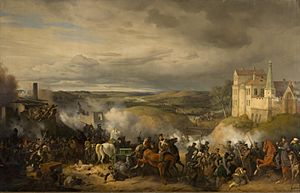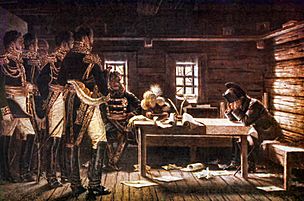Battle of Maloyaroslavets facts for kids
Quick facts for kids Battle of Maloyaroslavets |
|||||||
|---|---|---|---|---|---|---|---|
| Part of the French invasion of Russia | |||||||
 Battle of Maloyaroslavets, by Peter von Hess |
|||||||
|
|||||||
| Belligerents | |||||||
| Commanders and leaders | |||||||
| Strength | |||||||
| 24,000 | 24,000 | ||||||
| Casualties and losses | |||||||
|
6,000–8,000
|
8,000
|
||||||
The Battle of Maloyaroslavets happened on 24 October 1812. It was a key moment during Napoleon's French invasion of Russia. This battle helped Kutuzov, the Russian commander, force Napoleon to retreat. Napoleon's army had to go back along a path they had already destroyed. This made it much harder for them to find food and supplies.
Getting Ready for Battle
The last big battle before this was the Battle of Tarutino on 18 October 1812. The Russian army won that fight. After this, Napoleon decided to leave Moscow on 19 October 1812. He planned to march his army southwest towards a city called Kaluga.
Napoleon's army, known as the Grande Armée, was huge. It included about 90,000 soldiers ready to fight. There were also thousands of cavalry, support staff, and even many non-combatants. These were people like hospital patients, women, and people who had fled Moscow.
The lead French units, commanded by Alexis Joseph Delzons, headed for the village of Maloyaroslavets. Local people had destroyed the bridges over the Luzha River. Delzons' soldiers managed to enter the town. They quickly built a new bridge to cross the river. By the evening of October 23, the French had two battalions in the village.
The Fierce Fight
On 24 October 1812, General Dokhturov and his Russian troops arrived. They found the French had already taken a strong position near the bridge. A very intense battle began. General Raevski soon joined with 10,000 more Russian soldiers. They managed to take the town back, but not the bridge area.
The French commander, Eugene de Beauharnais, sent in his Italian division. These soldiers were led by Domenico Pino. By the end of the day, they had pushed the Russians out of the town again. The town of Maloyaroslavets changed hands at least eight times during the fighting! The Italian Royal Guard was especially brave.
Later, Marshal Kutuzov arrived. He decided not to have another huge battle the next day. Instead, he chose to move his army back to a prepared defense line near Kaluga. Even though the French and Italian forces won the battle that day, Napoleon realized something important. The path through Kaluga was now blocked. This meant Kutuzov had succeeded in his plan. He forced Napoleon to retreat north, back through Mozhaisk and Smolensk. This was the same path Napoleon had used to advance, and it was already ruined.
The French army lost about 6,000 to 8,000 soldiers. The Russians also suffered heavy losses, with about 8,000 killed or wounded.
Kutuzov's Smart Plan
After the battle, in the early morning of October 25, Kutuzov moved his army back in an organized way. They went south to protect the road to Kaluga. A British general named Wilson wanted Kutuzov to attack Napoleon's army right away.
But Kutuzov had a different idea. He believed that completely destroying Napoleon's army might not be the best thing for Russia in the long run. He wanted to make sure Napoleon's army was weakened enough to retreat, but not totally wiped out. His main goal was to force Napoleon onto a difficult path, not necessarily to capture him.
What Happened Next
The Battle of Maloyaroslavets was a strange victory for the French. They held the town, and the Russians moved back. But Napoleon did not chase them. In the long run, this battle was a big win for Russia. It stopped Napoleon from getting supplies and made his army much weaker.
On October 25, Napoleon himself was almost captured by a group of Cossacks. Luckily, his grenadier soldiers saved him. After this close call, Napoleon started carrying a bag of poison around his neck.
On October 26, Napoleon made the big decision to retreat. He ordered his army to go back through Mozhaisk and Borodino to Smolensk. This meant a long march of about 260 miles through land that was already destroyed. There were no towns left to offer shelter or food. This made the winter retreat incredibly difficult for his army.
By the night of October 27, the last of Napoleon's army left the ruined town. They crossed the river and joined the main retreat. Kutuzov ordered his Cossack troops, led by Platow, to follow Napoleon closely. The next big battle for the Russians was the Battle of Vyazma on 3 November 1812.
Kutuzov's army kept to the southern roads. These roads had more food and shelter. This way, they kept the French army from finding supplies. Kutuzov's next battle was the Battle of Krasnoi on 15 November 1812. The final major battle for Napoleon in this campaign was the Battle of Berezina from 26–29 November 1812.
See also


